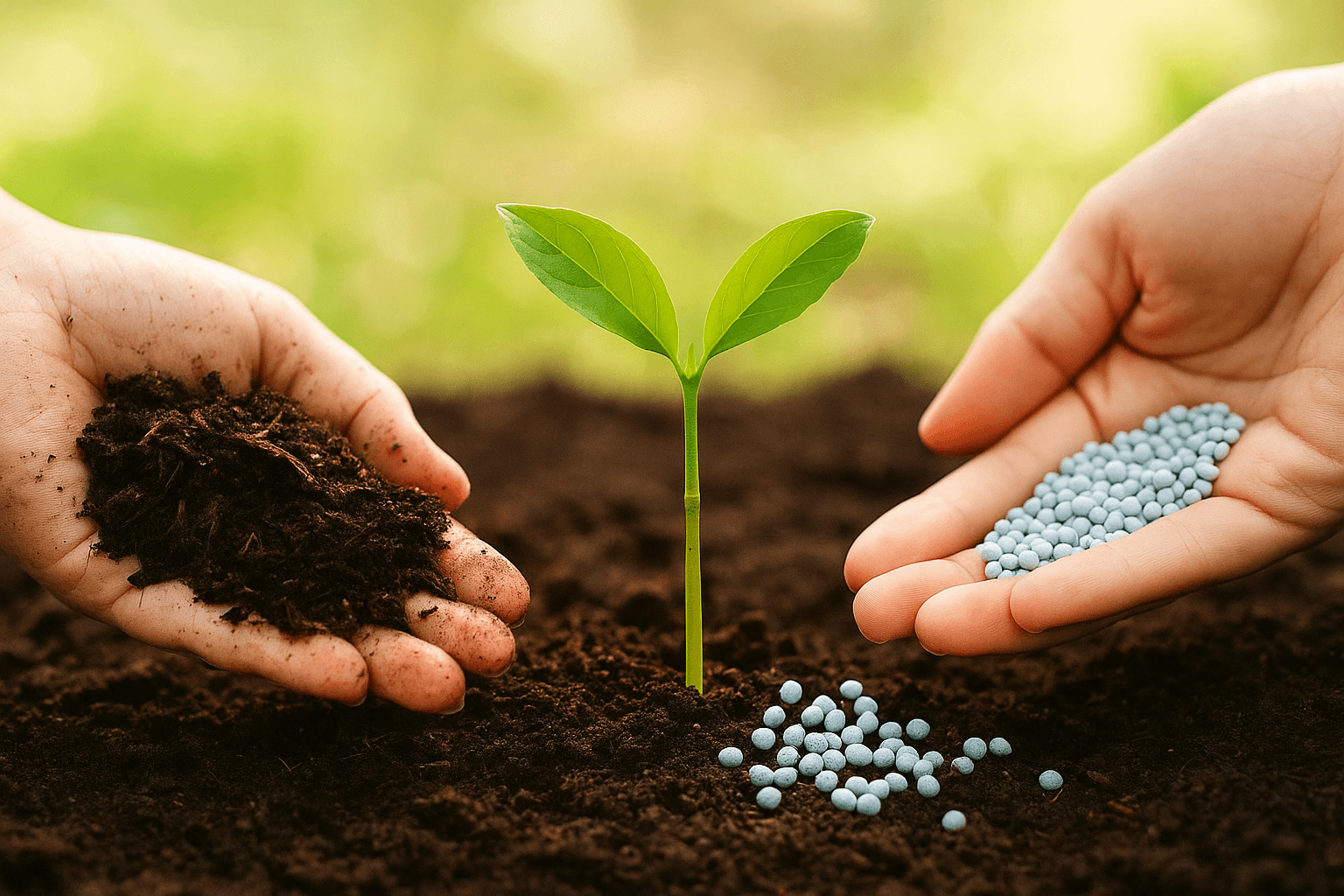
Organic Fertilizer vs Synthetic Fertilizer: Which is Better for Plants?

As the world’s population continues to grow, the demand for food is rising rapidly. Fertilizers play a vital role in supporting crop production and ensuring food security. Without fertilizers, soils quickly lose nutrients after repeated harvests, leading to declining yields. Today, farmers rely mainly on two types of fertilizers: organic fertilizers and synthetic (inorganic) fertilizers. Both serve the same purpose of supplying nutrients to plants, but they differ in origin, composition, performance, and impact on soil and the environment.
- What Are Organic and Synthetic Fertilizers?
- Key Differences Organic and Synthetic Fertilizers
- Advantages and Disadvantages Organic and Synthetic Fertilizers
- Combining Both for Sustainable Farming
What Are Organic and Synthetic Fertilizers?
Organic fertilizers are derived from natural materials such as animal manure, crop residues, or composted organic waste. Their production process is relatively simple, usually involving composting or decomposition. Beyond adding nutrients, organic fertilizers improve soil structure, increase microbial activity, and enhance long-term soil fertility.
Synthetic fertilizers, on the other hand, are manufactured in factories using industrial processes and raw materials like natural gas, phosphate rocks, and potassium minerals. Common examples include urea, SP-36, potassium chloride (KCl), and NPK blends. These fertilizers are valued for their high nutrient concentration and ability to deliver immediate results for plant growth.
Key Differences Organic and Synthetic Fertilizers

1. Origin
Organic fertilizers come from natural sources such as livestock waste, crop residues, or green manure. Synthetic fertilizers are produced industrially using chemical and physical processes, often involving the Haber-Bosch method to produce ammonia.
2. Nutrient Content
Organic fertilizers contain relatively low levels of nutrients but are rich in organic matter that benefits the soil. Synthetic fertilizers provide high and measurable amounts of essential macronutrients like nitrogen (N), phosphorus (P), and potassium (K).
3. Mode of Action
Nutrients in organic fertilizers are released slowly as the material decomposes, meaning the effects are not immediate. Synthetic fertilizers, in contrast, provide nutrients in a readily available form, leading to rapid plant uptake and faster growth.
4. Soil Impact
Organic fertilizers improve soil structure, water retention, and biological activity, contributing to long-term soil health. Excessive use of synthetic fertilizers, however, can lead to soil acidification, reduced microbial populations, and declining soil quality over time.
5. Environmental Impact
Organic fertilizers are environmentally friendly, help recycle waste, and reduce reliance on chemical inputs. Still, if not properly processed, they can cause unpleasant odors or carry pathogens. Synthetic fertilizers, while effective, may contribute to water pollution through nitrate leaching, increase greenhouse gas emissions, and harm ecosystems when overused.
Advantages and Disadvantages Organic and Synthetic Fertilizers
| Variabel | Organic Fertilizers | Synthetic Fertilizers |
| Advantages | Enhance soil fertility over the long term Environmentally friendly Utilize agricultural and animal waste | Provide nutrients quickly High nutrient concentration Easy to calculate and apply precise doses |
| Disadvantages | Low nutrient content Require large application volumes Work slowly and show results later | May degrade soil quality if overused Less environmentally sustainable More expensive and dependent on global supply chains |
Read more:
What is the best type of fertilizer?
Combining Both for Sustainable Farming
In practice, relying solely on one type of fertilizer often proves insufficient. A balanced combination of organic and synthetic fertilizers is widely recommended. Synthetic fertilizers provide immediate nutrients for crop growth, while organic fertilizers sustain soil health and fertility in the long term. This integrated approach, known as balanced fertilization, helps farmers achieve higher yields while protecting the environment and ensuring soil productivity for future generations.
Organic and synthetic fertilizers each have unique strengths. Organic fertilizers excel in maintaining soil health and supporting sustainable farming, while synthetic fertilizers offer fast, measurable results and high efficiency. For modern agriculture, the best solution lies in combining both wisely, ensuring not only higher productivity but also environmental sustainability.
Whether organic or synthetic fertilizers are used by the public, their formulas must be tested in a laboratory before they can be used. However, not all laboratories can test fertilizer products. As a fertilizer formulator or manufacturer, you must choose a trusted, competent, and accredited laboratory. Be careful not to choose the wrong laboratory testing partner, as inaccurate test results could lead to your product being discontinued.
Author: Fachry
Editor: Sabilla Reza
References:
Maguire, R., Alley, M., & Flowers, W. (2019). Fertilizer types and calculating application rates. Virginia Cooperative Extension, Virginia Tech.
Fertilizers Europe. (2018). Fertilizer basics: Why we need fertilizers, where they come from, how they work, and how they are used. Brussels: Fertilizers Europe.
Purba, T., Situmeang, R., Rohman, H. F., Mahyati, A., Firgiyanto, R., Junaedi, A. S., … Suhastyo, A. A. (2021). Pupuk dan teknologi pemupukan. Medan: Yayasan Kita Menulis.



